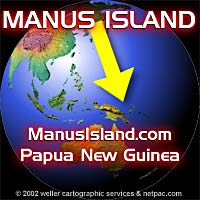Aria - That's it. Lele equivalent is "akara"
Cut buai - An expression in Nali and Lele languages which literally
means to distribute buai. When you get distributed a buai you accept
the responsibility of bringing food etc to the feast or function.
Dranou - A Lele village on the Highway. It isabout half an hour's
drive from Lorengau. Also spelt N'Dranou.
Hihisuu - A most important, or vantage, spot on a piece of land
where a ritual dedication usually takes place before it is cleared
for gardening. Usually the crop for the new garden is taro.
Kakiniy - This is the name of a small river on the South of Manus -
in the Nohang area just west of Patusi and Old Pere. In the past it
was an important market between the inland villagers and the Titans
of Patusi and Pere.
Kaliu - A place in the Yiriu (Yiliu) village.It is near the famous
Pokop haven of Pwenet.
Karuka - Rain coat made from pandanus leaf (Tok Pisin)
Kaluu - An old name of the mouth of river Lawes (Yowos, Yowes). In
the old times an important market thrived there.
Kawar - Tok Pisin word for ginger
Keyau - This is a wooden bed for lapans or chiefly people. Occupies
a prominent position in the men's house. Only lapan men's houses
have rights to have Keyaus.
Konga - A fictional land and or place outsideof Manus where the dogs
settled when they left Manus.
Kopou - A Nali village. It is towards the south coast, about half an
hour by car from M'Bunai village. Sometimes speltKapou.
Koyau - A tapa cloth-like garment made from bark of a tree usually
worn by women.
Kuiniy - I (will) eat it
BACK TO TABLE OF CONTENTS
Line - This refers to family, relatives. Family group
Liyiu - A term used in both Nali and Lele languages which refers to
a certain type of bad spirits or devils.
Masah - A big feast in which the bride price is paid
Mwalah - Light shower. Rain which comes with the sun.
Nambuyum - Your wife or husband. Same as Nali
Nasi - Nali word meaning "grandmother". Lele equivalent is "tato"
N'Dau - Lele word for wild ton. Tok Pisin is pakpak
N'Drawiying - Head rest. Same in Nali/Lele
N92Drop - Manus woven basket. Lele equivalent is n'dop. It is also
the name of the tree whose bark is used for the basket.
Nolou - Cordelyne. Tok Pisin name is tanget.
Par - Tree stump, trunk; stalk of a rope. Nali equivalent is "para".
Nosum - Your in law. Same in Nali but produced differently.
Pasinei - Platform used for ceremonial performance during masah and
yon. Usually carved and decorated.
Pram - Lengths of valuable beads used in Manus as a means of
exchange
Payai - Lele and Nali name for a creeper which is found throughout
Manus. It is the most used creeper in the inland villages and both
its leaves and sap have medicinal values.
Parahiy - Lele and Nali word for "ginger".
Pihin - Woman, girl. The term "pihi" means "woman of". Same in Nali
and Lele
Perei - An edible substance obtained from shale and dried in the
sun. A rare delicacy.
Pohyomou - A hilltop near the villages of Tingou and Yirngou.
Traditionally famous because of its association with thePokop
stories. Today they also call it Polomou.
Pwenet - Another hilltop associated with the Pokops. It is in the
present village area of Sirah.
BACK TO TABLE OF CONTENTS
Rauhuh - A Nali word which means clearing theundergrowth. It is the
first stage of preparation for a taro garden. Usually a task done by
the women. In the Lele language the word is "tauhuh"
Saleu - An expression of yearning or missed opportunity in both Lele
and Nali languages.
Salih - Nali word for staghorn. Lele equivalent is "silih"
Sinai - Nali word for devil. Lele equivalent is "sinei".
Sindrik - Word in Lele and Nali meaning to cut or snap
Sohol - Front and extended part of a haus boior haus marit. The Nali
equivalent is "sohal"
Sohoniliu - Nali village which borders the Lele villages of Dranou
Pnd Yirngou. Also spelt Sohoniriu.
Sumbrelendriy - A point along the Highway just before Pihpun village
(Sapon). From the mouth of the Lawes River it provided an ideal spot
to rest after the climb from the Kaluu market.
Tambu - 1. Brother/sister/father/mother in law; 2. Means forbid; 3.
Valuable beads string together in different lengths.
Tanget - Same as nolou above
Tarau - Another place associated with the Pokops. This is the old
name for the larger of the two N'Dropa islands.
Tatom - Your grand son or daughter; grandmother. Nali equivalent is
"tuhum".
Tiyiy - Another creeper used in house building. It is stronger than
the payai and can last for a long time. Nali equivalent is "taiyiy"
Toroko - Like this; this way. Nali equivalentis "toro"
Walah - Nali and Lele word for moon or areca leaf chewed with buai
Womolo - Two of you. Nali equivalent is "wamolu"
Wuloh - A Lele and Nali word for "thank you".
Yiringou - Last Lele speaking village on the Highway just after
Dranou. Yiringou used to be a Nali speaking village. Sometimes spelt
- Yirngou.
Yo - Me. Both Lele and Nali.
Yon - A big feast. Same in Lele and Nali. Similar to "masah" but for
quite different reasons.
Yopai- Lele - Nali word for temporary bush shelter or leaves carried
to keep dry from the rain.
Yowos - A river which starts at Yiringou and Tingou and empties into
the sea near Yowes village. In the Nali speaking villages it is
"Yowes". Tok Pisin is "Lawes"
Yukuyiy - A river in the South Coast where there was a famous
market. It enters the sea between Sowou and Londruu villages.
